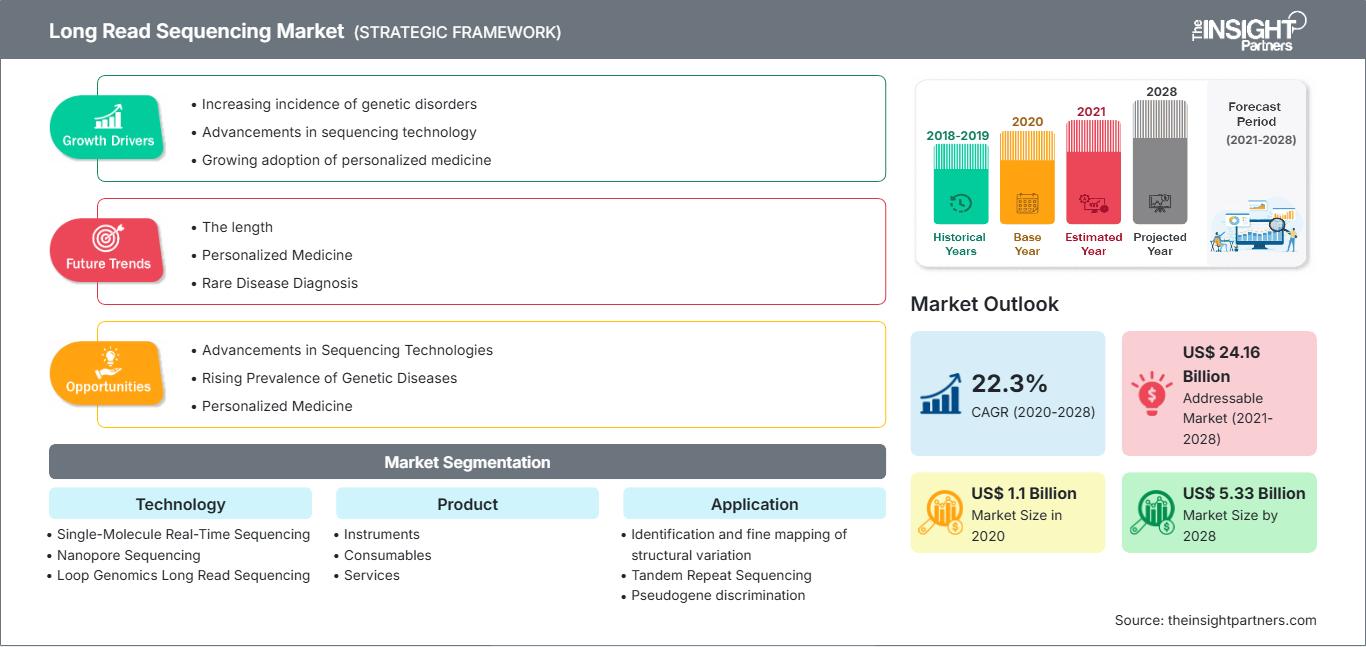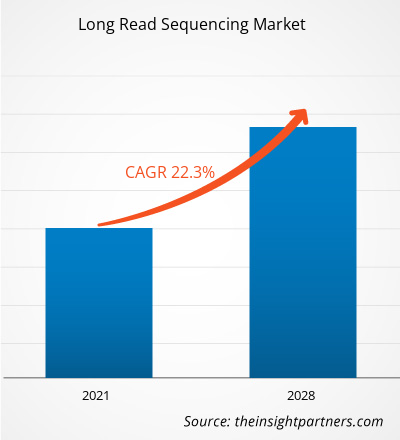El mercado de secuenciación de lectura larga se valoró en US$ 1.101,15 millones en 2020 y se proyecta que alcance los US$ 5.334,68 millones para 2028; se espera que crezca a una CAGR del 22,3% durante 2021-2028.
La secuenciación de lectura larga es una técnica de secuenciación de ADN. Ofrece numerosas ventajas distintivas en comparación con las tecnologías de secuenciación de nueva generación, como la secuenciación más precisa del ADN que contiene las mismas secciones de ADN repetidas dentro del genoma. Muchos adultos de 60 años o más padecen dos o más enfermedades crónicas. Los genes desempeñan un papel en enfermedades crónicas como las enfermedades cardiovasculares, la diabetes, la obesidad, la artritis reumatoide (AR), la enfermedad de Alzheimer (EA) y la depresión, según una investigación con gemelos. Según los Centros para el Control y la Prevención de Enfermedades (CDC), aproximadamente 6 de cada 10 personas en EE. UU. padecen al menos una enfermedad crónica, y 4 de cada 10 padecen dos o más enfermedades crónicas. Además, el cáncer se debe principalmente a errores genómicos. Los investigadores han analizado genomas de cáncer utilizando diversas tecnologías de secuenciación en rápida evolución para comprender mejor el estado molecular de las células cancerosas y exponer sus vulnerabilidades, como las mutaciones impulsoras o la expresión génica. Los investigadores pudieron reconocer y clasificar nuevas formas de mutaciones cancerosas utilizando tecnologías de lectura larga, incluyendo variantes estructurales complejas en la resolución de haplotipos. En los últimos años, se han desarrollado y utilizado diversas tecnologías de secuenciación de lectura larga. Por ejemplo, Pacific Biosciences desarrolló la secuenciación SMRT, uno de los métodos de lectura larga (PacBio). La secuenciación de lectura larga es cada vez más común, y los estudios sobre el cáncer basados en datos de lectura larga están creciendo y avanzando para decodificar genomas oncológicos complejos.
Obtendrá personalización en cualquier informe, sin cargo, incluidas partes de este informe o análisis a nivel de país, paquete de datos de Excel, así como también grandes ofertas y descuentos para empresas emergentes y universidades.
Mercado de secuenciación de lectura larga: Perspectivas estratégicas

- Obtenga las principales tendencias clave del mercado de este informe.Esta muestra GRATUITA incluirá análisis de datos, desde tendencias del mercado hasta estimaciones y pronósticos.
Perspectivas del mercado: Las ventajas de la secuenciación de lectura larga impulsan el mercado de la secuenciación de lectura larga
Las tecnologías de lectura larga están superando las limitaciones iniciales de precisión y rendimiento y aumentando su aplicación en los campos de la genómica. La secuenciación de lectura larga o secuenciación de tercera generación ofrece varias ventajas sobre la secuenciación de lectura corta. Mientras que los secuenciadores de lectura corta como los instrumentos HiSeq, NovaSeq, NextSeq y MiSeq de Illumina, los modelos MGISEQ y BGISEQ de BGI; o los secuenciadores Ion Torrent de Thermo Fisher producen lecturas de hasta 600 bases, las tecnologías de secuenciación de lectura larga generan regularmente lecturas de más de 10 kb. Además, las lecturas largas pueden mejorar el ensamblaje de novo, la certeza del mapeo, la identificación de isoformas de transcripción y la detección de variantes estructurales. Además, la secuenciación de lectura larga de moléculas nativas, es decir, ADN y ARN, elimina el sesgo de amplificación al tiempo que preserva las modificaciones de bases. Con el progreso continuo en precisión, rendimiento y reducción de costos, estas capacidades han comenzado a hacer de la secuenciación de lectura larga una opción para una amplia gama de aplicaciones en genómica para organismos modelo y no modelo.
Tecnología: Perspectivas
El mercado global de secuenciación de lectura larga, basado en la tecnología, se segmenta en secuenciación en tiempo real de moléculas individuales (SMRT), secuenciación por nanoporos y secuenciación de lectura larga de bucle genómico. El segmento de secuenciación en tiempo real de moléculas individuales (SMRT) tuvo la mayor participación de mercado en 2020. Sin embargo, se espera que el segmento de secuenciación de lectura larga de bucle genómico registre la mayor tasa de crecimiento anual compuesta (TCAC) del mercado durante el período de pronóstico.
Producto: Según el producto, el mercado global de secuenciación de lectura larga se segmenta en instrumentos, consumibles y servicios. El segmento de instrumentos tuvo la mayor participación de mercado en 2020, y se espera que el segmento de servicios registre la CAGR más alta entre 2021 y 2028.
Aplicación: Según la aplicación, el mercado global de secuenciación de lectura larga se segmenta en identificación y mapeo preciso de variación estructural, secuenciación de repeticiones en tándem, discriminación de pseudogenes, resolución de fases alélicas, genómica reproductiva, cáncer, secuenciación viral y microbiana, entre otros. El segmento de identificación y mapeo preciso de variación estructural tuvo la mayor participación de mercado en 2020, y se espera que el segmento de cáncer registre la CAGR más alta entre 2021 y 2028.
Flujo de trabajo: Según el flujo de trabajo, el mercado global de secuenciación de lectura larga se segmenta en presecuenciación, secuenciación y análisis de datos. El segmento de secuenciación tuvo la mayor participación de mercado en 2020 y se espera que registre la mayor tasa de crecimiento anual compuesta (TCAC) entre 2021 y 2028.
Usuario final: Según el usuario final, el mercado global de secuenciación de lectura larga se segmenta en institutos de investigación académica, hospitales y clínicas, y empresas farmacéuticas y biotecnológicas.
Perspectivas regionales del mercado de secuenciación de lectura larga
Los analistas de The Insight Partners han explicado detalladamente las tendencias y los factores regionales que influyen en el mercado de secuenciación de lectura larga durante el período de pronóstico. Esta sección también analiza los segmentos y la geografía del mercado de secuenciación de lectura larga en América del Norte, Europa, Asia Pacífico, Oriente Medio y África, y América del Sur y Central.
Alcance del informe de mercado de secuenciación de lectura larga
| Atributo del informe | Detalles |
|---|---|
| Tamaño del mercado en 2020 | 1.100 millones de dólares estadounidenses |
| Tamaño del mercado en 2028 | 5.330 millones de dólares estadounidenses |
| CAGR global (2020-2028) | 22,3% |
| Datos históricos | 2018-2019 |
| Período de pronóstico | 2021-2028 |
| Segmentos cubiertos | Por tecnología
|
| Regiones y países cubiertos | América del norte
|
| Líderes del mercado y perfiles de empresas clave |
|
Densidad de actores del mercado de secuenciación de lectura larga: comprensión de su impacto en la dinámica empresarial
El mercado de secuenciación de lectura larga está creciendo rápidamente, impulsado por la creciente demanda del usuario final debido a factores como la evolución de las preferencias de los consumidores, los avances tecnológicos y un mayor conocimiento de los beneficios del producto. A medida que aumenta la demanda, las empresas amplían su oferta, innovan para satisfacer las necesidades de los consumidores y aprovechan las tendencias emergentes, lo que impulsa aún más el crecimiento del mercado.

- Obtenga una descripción general de los principales actores clave del mercado de secuenciación de lectura larga
Los actores que operan en el mercado de secuenciación de lectura larga adoptan estrategias de colaboración y asociación para satisfacer las demandas de los usuarios finales mediante la introducción de ofertas tecnológicamente avanzadas, y estas estrategias respaldan significativamente el crecimiento del mercado.
Por tecnología
- Secuenciación de moléculas individuales en tiempo real (SMRT)
- Secuenciación de nanoporos
- Secuenciación de lectura larga de Loop Genomics
Por producto
- Instrumentos
- Consumibles
- Servicios
Por aplicación
- Identificación y mapeo preciso de la variación estructural
- Secuenciación de repetición en tándem
- Discriminación pseudogénica
- Resolución de la fase alélica
- Genómica reproductiva
- Cáncer
- Secuenciación viral y microbiana
- Otros
Por flujo de trabajo
- Pre-secuenciación
- Secuenciación
- Análisis de datos
Por el usuario final
- Institutos de investigación académica
- Hospitales y Clínicas
- Empresas farmacéuticas y biotecnológicas
Por geografía
- América del norte
- A NOSOTROS
- Canadá
- México
- Europa
- Francia
- Alemania
- Italia
- Reino Unido
- España
- Asia Pacífico
- Porcelana
- India
- Corea del Sur
- Japón
- Australia
- Oriente Medio y África
- Sudáfrica
- Arabia Saudita
- Emiratos Árabes Unidos
- América del Sur y Central
- Brasil
- Argentina
Perfiles de empresas
- Tecnologías de nanoporos de Oxford
- Biocentro Tataa
- Illumina, Inc
- Perkinelmer Inc.
- F. Hoffmann-La Roche Ltd.
- Baseclear BV
- Genómica bionano
- Tecnologías Longas
- Biociencias del Pacífico de California, Inc.
- Quantapore, Inc.
- Análisis histórico (2 años), año base, pronóstico (7 años) con CAGR
- Análisis PEST y FODA
- Tamaño del mercado, valor/volumen: global, regional y nacional
- Industria y panorama competitivo
- Conjunto de datos de Excel
Informes recientes
Testimonios
Razón para comprar
- Toma de decisiones informada
- Comprensión de la dinámica del mercado
- Análisis competitivo
- Información sobre clientes
- Pronósticos del mercado
- Mitigación de riesgos
- Planificación estratégica
- Justificación de la inversión
- Identificación de mercados emergentes
- Mejora de las estrategias de marketing
- Impulso de la eficiencia operativa
- Alineación con las tendencias regulatorias




















 Obtenga una muestra gratuita para - Mercado de secuenciación de lectura larga
Obtenga una muestra gratuita para - Mercado de secuenciación de lectura larga